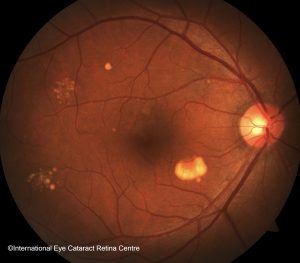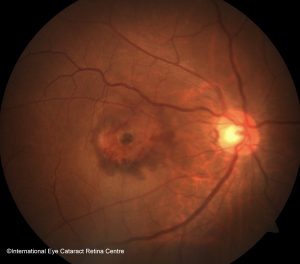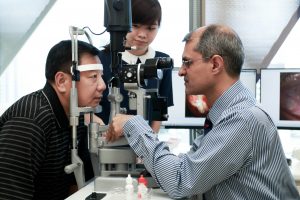
Dr Ajeet Madhav Wagle
MBBS(India) FRCS(Edinburgh) FAMS(Ophthalmology)(Singapore)
By Dr Ajeet Madhav Wagle, Medical Director and Senior Consultant Ophthalmologist, International Eye Cataract Retina Centre at Mount Elizabeth Medical Centre and Farrer Park Medical Centre, Singapore
Each month, the American Academy of Ophthalmology recognises one or more observances dedicated to raising awareness about eye health topics. February is Age-related Macular Degeneration (AMD) Awareness Month.
WHAT IS AMD?
AMD is a deterioration in the health of the macula, the most crucial central portion of the retina in the back of the eye. With AMD, one loses central vision which is critical for activities of daily living such as reading, driving and recognising faces.
IMPACT OF AMD
AMD is a potentially blinding eye disease. In fact, it is the most common cause of non-avoidable blindness in individuals 60 years and older in developed countries. About 8 million people worldwide are blind or severely visually disabled because of AMD.
In Singapore, the prevalence of AMD is estimated to be about 5.1% (5 out of every 100 individuals) for early AMD and 0.5% (1 in every 200 individuals) for late AMD. Interestingly, there is no major racial differences in the prevalence of AMD in Singapore. As a result of increased life expectancy and the proportion of elderly people in the community, AMD will become even more common in the near future.
RISK FACTORS FOR AMD
As its name suggests, AMD is strongly associated with ageing. The greater the age, the higher the likelihood of developing the disease. Almost one in every four individuals over the age of 80 has some form of the disease.
Fortunately, some AMD risk factors are potentially modifiable. The risk of developing AMD can be significantly reduced by avoiding smoking, taking a diet rich in protective antioxidants (lutein, zeaxanthin, vitamin C and vitamin E) and fish, and avoidling exposure to harmful ultraviolet light.
TYPES OF AMD
There are two main forms of AMD – “dry” and “wet” AMD.
- DRY AMD: This is the more common form of AMD. It accounts for about 9 out of 10 patients with AMD. Dry AMD is characterised by loss of vital cells in the macula and the appearance of yellow deposits in the retina called drusen. The disease generally progresses very slowly. Currently, there is no proven treatment for dry AMD. However, taking high dose antioxidant supplements has been shown to reduce the risk of progression of the disease in two major clinical trials – the Age-related Eye Disease Study (AREDS) and AREDS 2.

- WET AMD: This form of AMD is less common but much more serious than dry AMD. Wet AMD is characterised by the presence of abnormal blood vessels that grow under the macula. These abnormal vessels leak blood and/or fluid which eventually result in severe permanent vision loss from scarring in the macula. Vision loss occurs much faster with wet AMD than with dry AMD. Wet AMD is currently treated with eye injections of special drugs which block the effect of certain growth factors that are required for blood vessel growth under the macula. These newer treatments have revolutionised and dramatically changed the treatment outcomes for patients over the past decade. Less commonly, other treatment options such as “cold” or “hot” laser treatments may be used.

IMPORTANCE OF EYE SCREENING FOR AMD
Many people with early AMD are unaware they have the condition until their vision becomes blurry. This is why it is important to have regular comprehensive eye examinations by an eye specialist to detect the disease before you develop any vision problems. Early detection is the first critical step to preventing vision loss from AMD. If you have early AMD, you can reduce your risk of the disease progressing to a more advanced stage by taking AREDS 2 formula dietary supplements daily.
It is recommended that those above the age of 55 years should have their eyes screened at least once a year if they have no visual symptoms. If they have any visual symptoms such as blurred or distorted central vision at any age, they should have an eye examination by a specialist as soon as possible. Early visual symptoms of AMD can also be detected with a simple self-test for central vision using the Amlser chart.
Don’t lose your vision to AMD. Be aware of risk factors of AMD. Make a commitment to health today. Plan for your family to visit your eye doctor for a comprehensive eye screening if you are 55 years and older.

